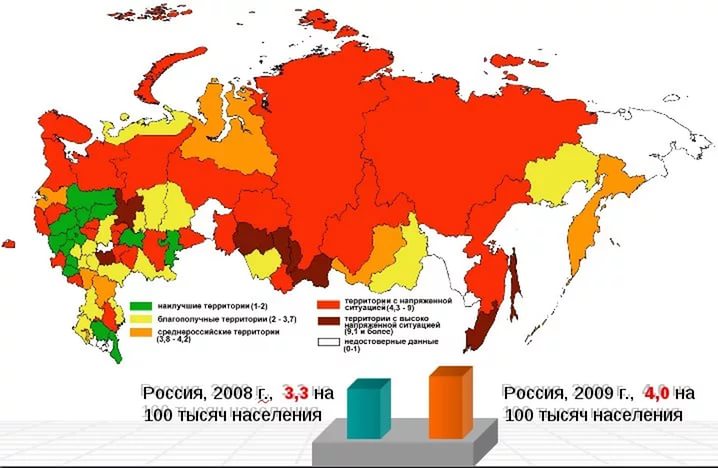
HIV infection in the world is one of the most progressive sexually transmitted diseases. It is also worth noting that AIDS statistics in the world, as a rule, absolutely do not correspond to the true picture of the spread of the disease, since research methods are based only on patients who are served in medical institutions. At the same time, most carriers of the infection and patients are not even aware of their infection due to the reluctance or lack of opportunity to see a doctor.
Another factor contributing to the concealment of truthful information about the spread of AIDS in the world is the fear of politicians and doctors to be blamed for the inability to contain the avalanche of infection that is rapidly moving towards humanity.
The state of the spread of HIV in the world

The number of HIV-infected in the world is growing exponentially. This is primarily due to the fact that the problem of AIDS in the world does not lend itself to the basic rules for combating infectious diseases, which are based on the exclusion of one of the components of the epidemiological process:
- The source of the disease.
- Transmission path.
- A receptive contingent.
In the countries of the world, HIV has long become the number one problem. For the spread of each infection, a source is needed, a route of transmission that ensures that the virus reaches a susceptible population. In the case of HIV, there is no way to act on any of the three components that contribute to the spread of the disease. A huge problem is the fact that most people become infected from carriers of the virus, who are in the so-called "serological window", when a person is already infected, but the tests are still negative. It has not been possible to exclude the last factor for many decades, since the invention of a vaccine against immunodeficiency has been postponed indefinitely due to lack of knowledge, research and technical capabilities.
Considering the above, the statistics of HIV in the world will worsen every year, as many inhabitants of the planet underestimate the danger of the immunodeficiency virus. The current HIV epidemic situation in the world can only be influenced by the awareness of the population and support for the fight against AIDS at the state level.
Prevalence of HIV infection (AIDS) in the world

Only by the end of the eighties, the statistics of HIV-infected in the world reached indicators that shocked the world community. In 142 countries, the World Health Organization has detected more than 120 thousand people with AIDS and more than 100 thousand infected with a retrovirus. The real prevalence of HIV in the world is much higher than these data, since there is always a percentage of the population that is not registered with medical institutions and therefore cannot be taken into account in statistical indicators. There are also carriers who are not even aware of their infection. The AIDS epidemic in the world affects mainly people of reproductive age. This leads to a significant loss of the able-bodied population, a decrease in the birth rate of healthy children and, accordingly, a decrease in the health indicator of all layers of humanity.
How many HIV-infected are in the world?

The question that interests many is how many people are sick with AIDS in the world today? The countries of southern Africa, India, Russia, the USA and Latin America occupy the first place in terms of HIV in the world. In these states, infected people make up approximately 15% of the total population. Every year the number of HIV-infected in the countries of the world increases by 5-10 million. So, at the beginning of the XXI century, the number of AIDS patients in the world amounted to more than 60 million. The first place in AIDS in the world community is occupied by the countries of southern Africa. Due to the unstable economic situation, the ability to treat and identify HIV-infected is very difficult. This leads to the rapid and rapid spread of immunodeficiency among humans. The disease progresses very quickly to stage 4 - AIDS.
Epidemiological situation of HIV infection in the world

Countries in which the incidence of immunodeficiency is rapidly increasing:
- Brazil.
- countries of Central Africa.
- Haiti.
- Indonesia.
- Bangladesh.
- Pakistan.
- Mexico.
- Great Britain.
- Turkey.
The ways of spreading AIDS in the countries of the world to some extent depend on the economic situation in the state and on its policy in relation to HIV-infected people. There are such features:
- The countries of the European Union, the USA, Australia and New Zealand are characterized by a high early detection of the disease among the population. This is due to compulsory health insurance and relatively frequent high-quality medical examinations. According to the results of the study, it can be concluded that 80% of the infected were identified among homosexual men and drug addicts who use intravenous drugs. In childhood, the incidence is practically not recorded. This is due to the timely and high-quality treatment of infected pregnant women, which prevents the vertical transmission of immunodeficiency (from a sick mother to a healthy fetus through the placenta, blood, breast milk). Non-sexual infections in these countries are practically not recorded.
- For the states of Africa and the adjacent warm islands, as well as the states of the Caribbean, Indonesia, the rate of early detection of AIDS is very low. In these countries, most patients are heterosexual. Their age is 18-38 years old. Most of these people became infected through sexual contact with prostitutes. Studies show that more than 90% of them are infected with a retrovirus. In Africa, HIV transmission is often associated with sexual contact with a sick woman. More often, such intercourse additionally leads to diseases that are sexually transmitted. And genital ulcers that develop due to these pathologies lead to a higher probability of transmission of the pathogen. In such states, transfusion of blood and blood products from an infected donor to a healthy recipient is not uncommon.
- Countries where HIV has been introduced relatively recently. These include Asia and Eastern Europe. Retrovirus infection here occurs mainly through sexual contact. The highest risk of infection in people who have multiple sexual partners does not neglect unprotected relationships with prostitutes.
HIV in Russia

The Ural Federal District ranks first in terms of HIV in the Russian Federation. It registered about 800 patients per 100 thousand of the population, which is a very high indicator. Over the past 15 years, cases of detection of immunodeficiency in pregnant women have increased by 15% in Russia. Moreover, such women are registered at a later date, which leads to intrauterine infection of the fetus due to the lack of the necessary treatment in the early stages of embryo formation. Also, the Siberian Federal District claims the first place in AIDS in Russia, in which about 600 infected people are registered per 100 thousand of the population, of which most of them have the last stage of the development of the disease, that is, AIDS.
Medical news in the world of HIV
Nowadays, the task of creating a vaccine against a retrovirus in scientists is in the first place. Nowadays, a huge amount of research work is being carried out in the field of molecular microbiology, which undoubtedly brings mankind closer to the creation of an AIDS vaccine. Despite this, there are a number of factors that impede the possibility of obtaining such a drug:
- The high ability of the virus to mutate.
- A variety of strains of HIV (currently 2 types are known).
- The need to fight not only the retrovirus, but also the infected cells of the body, as well as AIDS-associated infections.

Due to the fact that the spread of HIV in the world is growing every year, many patients simply do not have time to wait for a vaccine. Therefore, the main way in the fight against this disease should be directed towards preventive measures. All HIV-positive people in the world receive free treatment, which ensures them the most comfortable life. With adequate and competent therapy, patients can live a full and long life. HIV treatment in the world is carried out in regional AIDS centers according to uniform standards and provides an individual approach to any patient, selection of a scheme depending on the stage of pathology progression. The main principle of medical care is maximum confidentiality.
AIDS is constantly spreading among the world's population, while it is not yet possible to completely cure it. Therefore, it is worth directing maximum efforts to the prevention of such a dangerous pathology.




